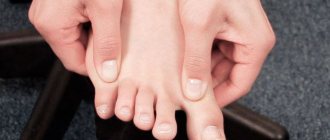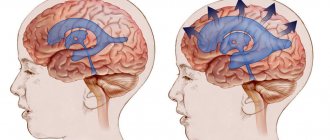There are many diseases that can cause pain and sensory disturbances in the foot. One of them, although not the most common, is Morton's neuroma. Many people suffering from this pathology say that they live with constant pain and walk “as if on sharp stones.” This is due to the growth of the nerve sheath and the false hope that everything will go away on its own. Unfortunately, this does not happen, and orthopedists, neurologists and therapists are often forced to deal with advanced cases of Morton's neuroma. Although it is possible to solve a problem that has been poisoning the lives of many people for years and does not allow them to enjoy active recreation and even walks in just 15-60 minutes.
What is Morton's neuroma
The foot is built in such a way that a thin metatarsal bone leads to each toe; their heads, together with the phalanges of the toes, form the metatarsophalangeal joints. In the immediate vicinity of the metatarsal bones, intermetatarsal nerves pass, branching into 2 branches in the area of the interdigital space. Each of these branches is responsible for transmitting nerve impulses to the lateral surfaces of neighboring fingers. In the area of the metatarsal heads, the interdigital ligament passes, touching the intermetatarsal nerves.
Morton's neuroma is a thickening of the intermetatarsal nerve sheath at the site of its division into 2 branches innervating two adjacent toes. Since it is located in close proximity to the heads of the metatarsal bones and the transverse ligament of the foot, these structures are capable of compressing the thickened nerve during walking and other types of physical activity, which leads to pain of varying degrees of intensity.
But the name of the disease does not accurately reflect its nature and essence. The concept of neuroma is widely used in oncology to describe tumors of the nerves, but in this case we are not talking about the formation of a tumor, and therefore the pathology has nothing to do with malignant processes. Since the formation of Morton's neuroma is accompanied by the formation of a thickening of the nerve, which can even be felt upon palpation, historically it came to be called a neuroma. The name has taken root in medicine, although it would be more correct to call this pathology Morton’s metatarsalgia.
Morton's neuroma is also called perineural fibrosis, intermetatarsal neuroma, plantar neuroma.
Morton's neuroma is one of the diseases accompanied by the development of carpal tunnel syndrome. In essence, it is a benign thickening of the nerve, formed as a result of thickening of its sheath and the formation of a connective tissue sheath around it. It was found that its dimensions can be 0.15-0.65 cm in width and 0.95-1.45 cm in length, i.e. the thickening has an elongated, spindle-shaped shape.
Most often, young women suffer from this pathology, and damage to the nerve trunk of only one of the feet is usually observed, although the development of a bilateral process is also possible. In most cases, the thickening is located between the 3rd and 4th toes, where the painful lump occurs. Somewhat less frequently, it forms in the 2nd interdigital space and very rarely in the 1st and 4th, i.e., at the big toe and little toe. Since the branches extending from the affected nerve innervate the lateral surfaces of the corresponding fingers, pain when irritated by the thickening tends to radiate to them.
Interestingly, Morton's neuroma almost never occurs in children. Their similar symptoms are usually caused by metatarsal fractures or metatarsophalangeal joint dislocations.
Thus, Morton's neuroma does not pose a threat to life, but can significantly reduce its quality, making it difficult to lead an active lifestyle and perform everyday tasks due to severe pain in the feet and fingers. Due to the resulting limitations in mobility, patients experience serious physical and psychological discomfort, which should not be tolerated. The possibilities of modern medicine make it possible to get rid of constant pain in the foot and restore the patient’s joy of life and movement.
General information
Orthopedic foot pathology in an industrial society tends to increase, as evidenced by the frequency of patient visits.
This is due to the sharply increased load on the foot, which is a complex anatomical formation, including 26 bones, 33 joints, 19 muscles, 107 ligaments and the neurovascular system, combined with the ankle joint into a single system, which allows effectively providing locomotor, spring and balancing functions in the process of walking, running and jumping. One of the common causes of foot dysfunction is Morton's disease (synonyms: Morton's neuroma, Morton's metatarsalgia, Morton's syndrome, interdigital neuroma, perineural fibrosis, foot neuroma, Morton's toe syndrome). Interdigital neuroma is a local limited thickening (formation) of the plantar nerve sheath of an elongated, fusiform shape at the level of the passage of the nerve between the heads of the metatarsal bones. The average size of a neuroma is 0.95–1.40 cm in length and 0.15–0.55 cm in width. It is believed that the disease manifests itself with local thickening of the nerve from 5 mm in diameter. In fact, Morton's neuroma is one of the manifestations of tunnel syndrome on the foot, that is, it is a tunnel (compression) neuropathy of the interdigital nerve of the foot.
Tunnel syndromes , which are characterized by compression with developing microcirculation disorders in peripheral nerves located in the so-called “tunnels” - anatomically narrow fibrous/fibro-osseous canals, are a fairly common form of damage to the peripheral nervous system. The trigger point for the development of the disease is multiple repeated microtraumas and nerve compression. There are no exact data on the epidemiology of the disease, but it has been established that it is relatively rare and women aged 35 to 60 years are much more likely to suffer. Morton's neuroma on both feet at the same time is rare; it is usually a unilateral nerve lesion. Complaints about severe pain and sensitivity disorders lead to loss of ability to work and a decrease in quality of life, and since patients are predominantly people of active working age, the significance of this problem is also of social importance.
Reasons for development
American surgeon Thomas George Morton in 1876 described a syndrome that he observed in 12 patients with unusual foot pain in the area of the 3rd interdigital space. He suggested that this is a consequence of mechanical compression of the nerve by the heads of the metatarsal bones. But today it is believed that in fact the disease is of a polyetiological nature.
The exact mechanism of formation of Morton's neuroma is not yet known, although various studies have been carried out in this direction, thanks to which a substantial amount of knowledge has been accumulated. As a result, there were suggestions that thickening of the nerve most likely becomes a consequence of constant overload of the forefoot, frequent repeated microtraumas, long-term, constantly repeated compression, i.e. squeezing, of the foot and, accordingly, the nerve. There is also evidence that nerve thickening can form as a result of ischemic phenomena, i.e., nutritional disorders, which can be observed when the walls of the blood vessels supplying a given area of the foot thicken or their lumen is completely blocked.
Therefore, today it is believed that nerve compression and constant microtrauma lead to a gradual thickening of the transverse intermetatarsal ligament of the foot with its disintegration and the development of edema. The formed pathological intermetatarsal ligament causes constant compression and displacement of the medial plantar nerve and the vessels that supply it, which provokes the occurrence of ischemic phenomena and compensatory thickening of the plantar nerve sheath.
Additional factors contributing to the development of the disease may be damage to bones and soft tissues, as well as the development of the inflammatory process, which is accompanied by the formation of an infiltrate. All this can lead to the nerve becoming firmly fused with the surrounding tissues, its sheath thickening to protect the delicate structure from damage, resulting in the formation of a space-occupying lesion. Since the distance from the intermetatarsal nerve to the metatarsal bones and interdigital ligament is extremely small, these anatomical structures compress the overgrown nerve sheath, i.e., its compression occurs, which causes the occurrence of tunnel syndrome with all its manifestations.
It is believed that genetic predisposition also plays a role in the occurrence of Morton's neuroma. Although the action of external and internal factors is still given leading importance.
Thus, the main reasons for the development of the disease are:
- transverse flatfoot and/or development of valgus deformity of 1 toe (Hallux Valgus);
- wearing shoes that are too tight, in particular narrow shoes with high heels, which explains the fact that the pathology is 4 times more common in women;
- injuries and formation of hematomas at the site of the nerves of the foot;
- gait disturbances with the foot turning inward, which leads to excessive tension on the nerve;
- vascular pathologies of the lower extremities, accompanied by fusion or closure of their lumen and acute circulatory disorders, i.e. obliteration (obliterating atherosclerosis, endarteritis of the lower extremities);
- obesity, leading to increased stress on the legs and feet in particular;
- increased loads on the forefoot;
- inflammatory diseases of the joints and ligaments of the feet (bursitis, tendovaginitis);
- some infectious and autoimmune diseases;
- lipomas of various types in the metatarsal area;
- changes in nerve anatomy.
Very often, Morton's neuroma occurs in women who constantly wear tight high-heeled shoes, as well as in people who actively engage in sports or are forced to stand for long periods of time. Excess weight and heavy physical labor or overly active sports are the main causes of pathology in men.
Pregnancy can act as a trigger for the rapid development of the disease. This is due to the relatively rapid increase in a woman’s body weight, which leads to an increase in the load on the foot. Therefore, it is extremely important from the first days of pregnancy to wear comfortable, non-squeezing shoes and avoid too much stress.
Thus, the risk group for developing Morton's neuroma includes:
- women who constantly wear narrow high-heeled shoes;
- people who are forced to stand or walk for a long time due to the nature of their profession (salespeople, teachers, flight attendants, waiters);
- people engaged in heavy physical labor (loaders, professional athletes, especially figure skaters, speed skaters, track and field athletes);
- patients with any diseases and deformities of the feet, especially flat feet, bursitis, arthrosis, tendinitis, tumors, hallux valgus.
Symptoms of Morton's neuroma
While the neuroma is small in size, i.e., does not reach 5 mm, it usually does not manifest itself in any way and patients do not even suspect the presence of any problem in the foot. In such cases, pain or a feeling of tightness may appear when putting on uncomfortable shoes and quickly go away after they are removed. Sometimes there is discomfort between the toes after wearing such shoes or a slight tingling sensation.
However, provided that the action of the provoking factors continues, the thickening begins to increase in size, which first leads to the appearance of shooting and aching pain in the area of the 3rd interdigital space. They usually occur after exercise and walking, and may also be accompanied by the development of various sensory disorders, including:
- crawling sensation;
- burning;
- tingling;
- pain of varying intensity arising from mechanical or thermal irritation.
Moreover, Morton's neuroma is characterized by an almost complete absence of any discomfort in the foot at night.
If at this stage of the development of the disease a person does not consult a doctor, and the cause of pain, paresthesia, allodynia and other sensitivity disorders is not established and, accordingly, treatment with lifestyle correction is not carried out, the symptoms of the disease continue to intensify. The frequency and severity of pain, which can become throbbing, gradually increases; the interval between the start of physical activity and the appearance of the first discomfort is observed to decrease. Often, pain syndrome forces a person to take off their shoes and massage the affected area of the foot. This is due to the continued growth of the nerve thickening.
The disease can have a wave-like course, that is, with periods of intensification of symptoms and their temporary subsidence or even elimination. Sometimes manifestations of the disease may be absent even for several years.
In the later stages of pathology progression, when Morton's neuroma reaches large sizes, patients suffer from:
- sharp, burning pain that can occur even at rest and does not depend on the type of shoes the patient wears;
- sensations of the presence of a foreign object in shoes (as a rule, patients talk about the feeling of a pebble getting into their shoes);
- increasing intensity of sensitivity disorders up to its complete loss;
- changes in gait with forced lameness, since it is difficult to step on the affected leg, and the need to frequently stop while walking.
What is characteristic of this disease is the complete absence of external changes in the condition of the foot and the affected interdigital space. In this case, when you press on the area where the thickening of the nerve is formed, the pain increases sharply.
Severe pain syndrome that occurs during physical activity makes it impossible to engage in sports that involve stress on the legs, i.e. running, jumping, dancing, skiing, roller skating, skating, etc. Even normal walking becomes a challenge for people with this pathology .
What is the cost of foot surgery?
In addition to the cost of surgical treatment for Morton's neuroma, it is worth considering the additional costs for diagnostics, doctor's appointments and aids (eg elbow crutches), amounting to approximately 1,500 to 2,00 euros. If you plan to undergo outpatient physical therapy treatment after surgery, we will be happy to provide you with an estimate of the costs. Information regarding the cost of hotel accommodation and possible additional treatment at a rehabilitation center can be found on the corresponding website.
Diagnostics
If signs of Morton's metatarsalgia develop, you should consult an orthopedist or neurologist. Diagnosis of the disease is not difficult, and in most cases the doctor can suspect the presence of this particular pathology only on the basis of data obtained during a survey and examination of the patient.
Finding out the characteristics of the shoes that a person is used to wearing, as well as the length of time he or she wears them every day, is of great diagnostic importance. The specialist will definitely inquire about the presence of chronic and autoimmune diseases, vascular disorders, past injuries, etc. During the examination, the doctor draws attention to the presence of excess weight, flat feet and the presence of pain when palpating the area between the 3rd and 4th fingers or others, depending on the where the discomfort is felt.
A special test can also be performed, which consists of pressing the 3rd intermetatarsal space for 30-60 seconds. The presence of Morton's neuroma is indicated by the occurrence of numbness and burning at this point, which can spread to the lateral surfaces of the 3rd and 4th fingers. Additionally, a positive Tinnel's sign can indicate the presence of Morton's neuroma, i.e., the occurrence of pain when tapping the metatarsal bones of the 3rd and 4th toes, as well as the appearance of severe pain when squeezing the forefoot and toes.
However, in order to confirm the benign nature of the disease and exclude a number of other pathologies that can be accompanied by similar symptoms, patients are prescribed instrumental research methods. Indeed, much more often than the development of metatarsalgia, pain in the foot is caused by various deformations, in particular flat feet, which can be one of the causes of Morton's neuroma, as well as chronic tendinitis of the Achilles tendon. Differentiation is also required with hereditary spastic paraplegia, synovitis, arthritis of the metatarsophalangeal joints, stress fractures, osteonecrosis of the metatarsal bones, and tumor formation.
Some pathologies of the spine may also be accompanied by pain and sensory disturbances in the foot, in particular intervertebral disc herniations in the lumbar region.
To diagnose Morton's neuroma, the following may be performed:
- MRI or magnetic resonance imaging is an effective method for diagnosing a huge number of different soft tissue diseases. But in the case of Morton's neuroma, it is not always able to provide comprehensive data to confirm or refute the diagnosis, and often gives questionable results.
- CT or computed tomography - allows you to obtain accurate information about the condition of bone structures, especially at the site of thickening of the nerve, the presence of flat feet, and the consequences of injuries.
- Ultrasound is one of the main methods for diagnosing the disease, as it allows you to accurately determine the area of thickening of the intermetatarsal nerve, as well as detect degenerative-destructive changes in the joints.
The presence of Morton's neuroma can also be confirmed as the cause of the appearance of pain and sensitivity disorders of varying degrees of severity through a therapeutic and diagnostic blockade. This is the name given to the injection of a local anesthetic solution carried out in close proximity to the passage of the intermetatarsal nerve. A rapid reduction to complete extinction of pain is a convincing diagnostic criterion, indicating the development of Morton's metatarsalgia.
Treatment of Morton's neuroma
For each patient, treatment tactics are developed individually, which largely depends on the stage of the disease, as well as the causes of its occurrence. In the initial stages of development, patients are usually recommended conservative therapy, which consists of:
- unloading the feet and abandoning tight shoes in favor of comfortable orthopedic ones with a small heel 2-4 cm high, ensuring proper distribution of the load on the foot;
- using metatarsal pads and lifts, which are special orthopedic inserts that are placed under the balls of the feet and fixed on the toes with elastic bands or silicone rings in order to separate the metatarsal bones and create an anatomically correct bend of the foot;
- wearing shoes with retrocapital support.
All these methods have one goal - reducing pressure on the affected nerve trunk. This will avoid further progression of the disease and reduce pain by reducing the load and compression of the intermetatarsal nerve.
In order to increase the effectiveness of the measures taken, patients are recommended to constantly wear orthopedic insoles specially made for them according to individual parameters. Thanks to this solution you will be able to:
- reduce the load on the forefoot and normalize the condition of the transverse arch, i.e., reduce flat feet;
- reduce the pressure of bones and ligaments on the modified nerve trunk;
- avoid the development or eliminate the inflammatory process in soft tissues, including those involving the nerve, which will make it possible to significantly reduce the intensity of pain;
- restore the anatomy of the foot, which will improve the gait and bring it closer to normal.
In the absence of severe pain, patients can be prescribed multicomponent compresses, which usually include NSAIDs, local anesthetics and dimexide, taking NSAID drugs orally in the form of tablets or capsules, or applying them directly to the interdigital space in the form of an ointment or gel. This helps to improve the condition, but does not have a pronounced therapeutic effect. In combination with compresses, muscle relaxants are usually prescribed, as well as manual therapy sessions, which can not only relieve muscle spasms and improve tissue nutrition by activating blood circulation, but also eliminate nerve compression by normalizing the position of the metatarsal bones and ligaments.
Additionally, you can massage your feet at home, as well as take relaxing baths with herbs.
Courses of physiotherapeutic procedures are also indicated. So, with Morton's neuroma, the following give a good effect:
- Magnetic therapy is a method that involves influencing the affected area with a pulsed magnetic field, which helps reduce inflammation, swelling and improve the course of metabolic processes in it;
- shock wave therapy (SWT) is a method of physical influence, through the use of which it is possible to improve blood circulation in the area of the thickening of the intermetatarsal nerve and thereby reduce the severity of ischemia, as well as accelerate the elimination of inflammation and achieve pain reduction;
- electrophoresis with the introduction of anti-inflammatory and analgesic drugs - ensures rapid and deeper penetration of drugs into tissues, and therefore obtains a more pronounced therapeutic effect;
- acupuncture – involves irritation of biologically active points, which helps to activate recovery processes.
Light therapeutic exercises are often additionally prescribed, the implementation of which does not take much time, but allows you to activate blood circulation in the legs, increase joint mobility, and also strengthen and stretch the muscles of the feet. But you need to do exercise therapy every day without haste at a pace that is convenient for you.
The main exercises include the following:
- Sitting on a chair with your feet firmly planted on the floor, you need to pull your socks towards you as much as possible, and then pull them forward.
- Standing facing the wall and leaning against it with outstretched arms, you need to take one leg back about 30-50 cm. The remaining leg in front is rhythmically bent at the knee, making sure that both heels are pressed firmly to the floor.
- Sitting on the floor with straight legs stretched out in front of you, use a towel to pull your feet towards you with your hands.
- Sitting on a chair, they make small movements with their toes, tearing them off and placing them on the floor, imitating playing the piano.
- Sitting on a chair, place one leg with the ankle joint on the knee of the other and perform rotational movements alternately in both directions, trying to make as wide a rotation as possible.
If these measures are not enough or a more severe course of the disease is initially observed, patients are prescribed corticosteroid injections, which are performed in the intermetatarsal space on the dorsum of the foot. In 50% of cases, this measure is enough to significantly improve well-being. Such blockades reduce swelling and inflammation, which leads to a decrease in pain.
In cases where concomitant orthopedic pathologies, such as deforming arthrosis, are detected in patients, treatment appropriate to the situation is prescribed.
However, conservative therapy is not always effective. Therefore, if patients, despite the measures taken, are still bothered by pain and other symptoms of Morton’s neuroma, they are recommended to undergo surgical treatment of the pathology.
Surgery for Morton's neuroma
The current level of development of orthopedics allows for effective and rapid treatment of Morton's neuroma at any stage of development. Today there are several techniques used for this purpose.
Often the thickening of the nerve trunk is removed, which is performed under local anesthesia. The surgeon individually chooses the type of access to the nerve: from the back or plantar side of the foot. He then makes a soft tissue incision to visualize the nerve and resects the thickened part. After this, the tissues are sutured and covered with a sterile bandage.
This operation lasts no more than an hour and involves the removal of a modified section of the nerve. This leads to a rapid improvement in the condition and complete disappearance of the pain syndrome with no risk of relapse of the disease, i.e. its re-development. But the method has a drawback - loss of sensitivity in the area of the foot for which the nerve was responsible for innervation.
The lack of sensitivity in such a small area does not in any way affect the supporting and motor function of the foot. It does not affect the patient’s condition and appears only when intentionally touching the area that has lost sensitivity. After such an operation, the recovery stage takes 2-4 weeks, during which it is recommended to reduce the load on the operated foot. You can get up and walk within a couple of hours after the operation, but you should limit the load on the forefoot, which is achieved through the use of special shoes with hard soles. The stitches are removed 2 weeks after the procedure.
However, loss of sensation even in a small area of the foot seems to many surgeons to be too high a price to pay for treating Morton's neuroma, especially as a primary measure. In such situations, such surgical intervention is considered as a last resort, which should be resorted to only in the absence of the expected effect from other measures. Therefore, they often initially try to cope with the problem and eliminate pain using less radical methods, for example, by cutting the transverse ligament between the metatarsal bones. The operation does not require special preparation and lasts only a few minutes. Dissection of the ligament will eliminate compression of the nerve trunk without compromising its integrity, and therefore preserve sensitivity. If the operation does not give the desired result, you should think about removing the neuroma by excision.
Also, to treat the disease, a surgical treatment technique such as osteotomy of the 4th metatarsal bone can be used. But today it is practically not used. The essence of this type of operation is to create space for the thickened nerve, which will allow it to be decompressed. This is achieved by performing an artificial fracture of the 4th metatarsal bone and displacing its head. Osteotomy and further manipulations are carried out under X-ray control through a minor soft tissue incision or even a puncture with a diameter of about 2 mm. In this case, the foot must be fixed with a plaster cast, and the recovery period increases to 1 month.
Recently, Morton's neuroma is increasingly removed by laser or radiofrequency ablation. The essence of both methods is approximately the same and consists in introducing, under local anesthesia, a thin cannula directly to the site of localization of the nerve thickening, through which a laser or radio wave probe is then immersed. Due to the receipt of thermal energy, the modified section of the nerve trunk is destroyed, which leads to the elimination of the pain syndrome, but also provokes a loss of sensitivity on the adjacent lateral surfaces of the 3rd and 4th fingers. Thus, laser and radio wave treatment of Morton's neuroma allows one to obtain the same effect as open surgery, but is not associated with the formation of scars on the skin, since the puncture size is only a few millimeters, is less traumatic and is easier to tolerate by patients. The duration of the operation is about 30 minutes.
Modern operations performed for Morton's neuroma allow patients to feel better in more than 90% of cases. Moreover, in 45% of cases there is a complete elimination of pain and neurological symptoms, in 32% there is a significant reduction in them. Only in 15% of cases the result was satisfactory, i.e., there was a decrease in pain and preservation of neurological disorders, and in only 8% of patients who underwent surgery, the situation did not change for the better. Negative results are usually due to the formation of a true amputation neuroma of the intermetatarsal nerve.
What type of anesthesia is offered to the patient before surgery?
Typically, surgical treatment of Morton's neuroma is performed under general anesthesia. If the patient refuses this method for personal reasons, there is the possibility of using spinal anesthesia. To do this, the surgeon injects an anesthetic into the spinal canal of the lumbar spine. In this case, the patient is fully conscious. What type of anesthesia is most suitable for the patient is determined during a conversation with the anesthesiologist. Our anesthesiologists are true masters of their craft, who during your appointment will offer you the best method that meets all the indicators of previous examinations.
Prevention
Morton's neuroma is a disease whose development can be avoided by following simple rules. First of all, prevention of the formation of thickening of the intermetatarsal nerve consists of:
- wearing narrow high-heeled shoes only on special occasions and for a short period of time;
- preference for comfortable shoes as the main ones;
- prevention of flat feet, which consists of performing a special set of exercises, including rolling a ball with the foot and lifting small objects from the floor with the toes;
- performing a foot massage;
- weight control and maintaining it at optimal levels;
- timely treatment of orthopedic disorders;
- refusal to engage in traumatic sports;
- rational loads on the lower limbs;
- timely diagnosis and treatment of foot injuries;
- prevention of the development of atherosclerosis and other vascular disorders, which is mainly achieved through a healthy diet and rational physical activity.
Thus, Morton's neuroma is a harmless, but extremely unpleasant disease, the development of which is much easier to avoid than to then deal with its consequences. Treatment of pathology in the early stages can be carried out using conservative methods, but without correcting habits and footwear it will not be successful. The most reliable and effective method of combating already formed Morton's neuroma is surgery. Modern techniques make it possible to radically solve the problem of pain in less than an hour and return a person to the ability to move without pain. At the same time, operations of this kind are associated with minimal risks of complications, do not require long and complex rehabilitation, and also allow you to return to most everyday activities the very next day after the procedure.
What are the conditions of stay at the Gelenk Clinic?
Private ward at the Gelenk Clinic in Gundelfingen, Germany.
© joint-surgeon During your stay at the Gelenk Clinic, you are usually in a separate room, which has a shower and toilet. In addition, we provide towels, bathrobes and slippers. You can also use a safe and minibar. All rooms are equipped with TV. You only need to take medications, comfortable clothes and nightwear with you. Patient care is provided around the clock. The medical staff and physiotherapists at Gelenk Clinic will always answer all your questions. Generally, the length of hospital stay is 3 days. Your relatives can stay at a nearby hotel. Our staff will be happy to take care of your room reservation.









